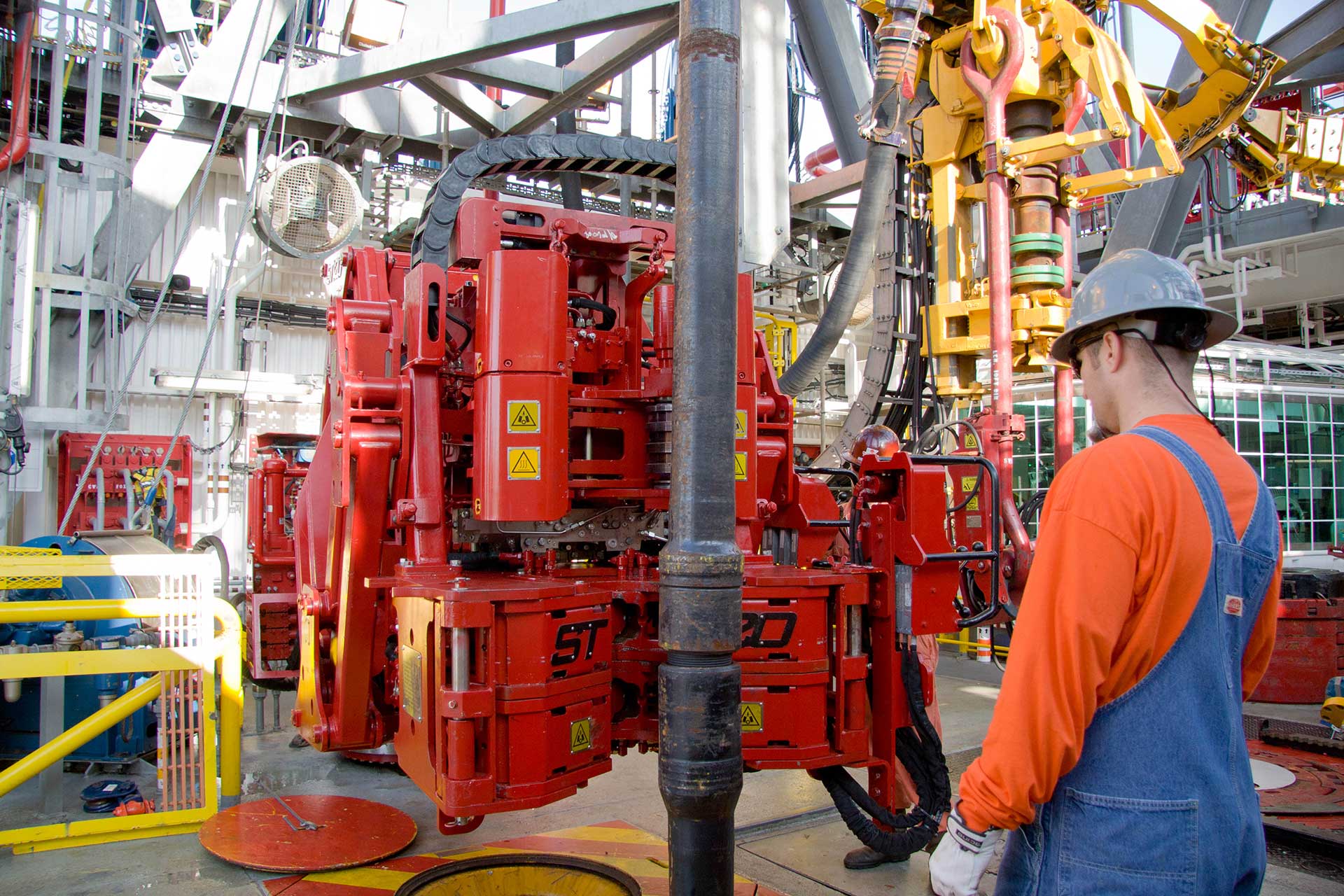Interfacing with Rig Tools
Best practices for using drill stem products with rig tools
How to interface your Grant Prideco drill stem products
Interfacing with the top drive
Top drive bell
The top drive bell (also called top drive flippers) is the piece of equipment that centers the top drive saver sub pin connection into the stand or string upper box connection. The bell inner diameter shall be adjusted to be at maximum ½ in. larger than the tool joint nominal OD.
Top drive saver sub (TDSS)
The TDSS lower pin connection is the most frequently made-up in the drill string. If damaged, it has the potential to propagate damage to the entire string. In most configurations there is a large diameter variation between the larger section of the sub and the critical bottom connection, and it is vitally important to have high strength, high toughness, and consistent hardness throughout the wall of the TDSS. Grant Prideco™ builds TDSS from double heat-treated or forged material because it extends the product service life.
Interfacing with the iron roughneck
Pressure from the iron roughneck jaws is important to avoid egging and tearing of tool joint material by slippage (increasing the pressure is not always the solution). The condition of the jaw dies affects their ability to bite, thus causing tearing of tool joint material by slippage. Check with the manufacturer for directions on iron roughneck maintenance.
Be sure to practice correct tong placement when making up connections (see the chart in the Specifications tab).
Makeup connections to the proper makeup torque (MUT). Do not hesitate to make connections up to the maximum MUT specified on the performance data sheet and apply correction for the thread compound friction factor (FF).
We recommend the use of iron roughnecks with multiple tong die points (take extra care with units with two dies that are 180° apart).
Note that not all iron roughnecks are designed to give an accurate break-out torque reading.
Interfacing with slips
Ensure that the level of tension in the string when on slips does not exceed the slip crushing capacity of the pipe. If so, consider the use of premium slips.
Stopping drill pipe with slips
Stopping the downward motion of drill pipe with slips will swedge and elongate the pipe in the slip area and will transfer an excessive load to the rotary table, master bushings, and slip bowl. Slips should not be dropped on a moving string.
Slip test
Clean a section of the pipe that is free of previous insert marks. Wrap waterproof paper around the cleaned section of pipe. Place rotary slips around the wrapped section of pipe and lower the pipe and slips with normal setting speed. The hook load must be a minimum of 100,000 lbs to ensure correct die marking on pipe. For removal, hold the slips together and raise pipe. Remove the slips carefully when hole is cleared. Remove paper carefully. If successful, the paper should display a regular pattern of die marks from top to bottom and circumferentially.
Interfacing with the elevator
Most drill pipe and HWDP come with an 18° taper to be used with an 18° elevator to hoist the string, but in some cases a 90° elevator is used. As the tool joint OD wears, the contact area and elevator capacity are both reduced. In order to operate safely, check the elevator capacity curve provided in our Performance Data Sheets.
If the elevator shoulder is size-limited, premium elevators with higher-strength bushings can be used instead. This provides improved hoisting capacity.
Drill collar elevator recesses (ER) are typically 90° elevators and are sensitive to wear and loss of OD. ERs are also stress risers with a sharp transition radius, and they are prone to fatigue crack initiation and propagation. Inspect your collar recesses thoroughly and avoid using collars with worn ERs. It is recommended that lift subs be used when possible as a safety precaution and to save time.
Drill Pipe Running and Handling
Proper running and handling is essential. We help you save time and reduce costs.
Related Products
Running and Handling for Drill Stem Products
Best practices for running and handling to properly care for and maintain your Grant Prideco drill stem products
Care and Maintenance of Rotary-Shouldered Connections
Get more out of your drill string by properly maintaining your Grant Prideco drill stem products.
Picking Up New Pipe and BHA Components
Best practices for picking up new Grant Prideco pipe and bottomhole assembly (BHA) components
Troubleshooting for Drill Stem Products
Recommendations to address potential issues encountered when running drill string products
Grant Prideco Licensee Network
Our extensive network of licensed repair facilities provides global service and support for Grant Prideco products.
Grant Prideco Technical Resources
Supporting our customers is our highest priority, and we look forward to partnering with you today and every day to achieve lasting success.
Rotary and Handling Tools
High-quality pipe-handling tools backed by more than 150 years of combined experienced in the industry
Pipe Handling Systems
As the industry’s leading provider of horizontal and vertical pipe-handling and racking systems, we deliver turnkey solutions and upgrades for traditional, mechanized, and fully automated drill floors.
Iron Roughnecks
As the versatile, safe, and dependable solution for making tubular connections on the drill floor, our iron roughnecks minimize rig floor hazards and streamline the make-and-break process.
